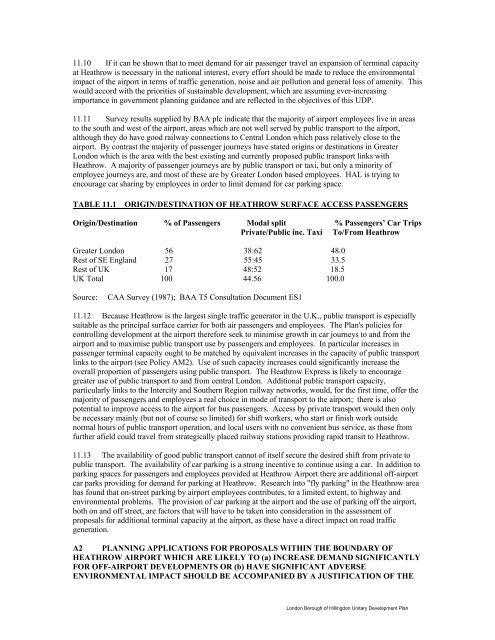HILLINGDON UNITARY DEVELOPMENT PLAN - London Borough ...
HILLINGDON UNITARY DEVELOPMENT PLAN - London Borough ...
HILLINGDON UNITARY DEVELOPMENT PLAN - London Borough ...
Create successful ePaper yourself
Turn your PDF publications into a flip-book with our unique Google optimized e-Paper software.
11.10 If it can be shown that to meet demand for air passenger travel an expansion of terminal capacity<br />
at Heathrow is necessary in the national interest, every effort should be made to reduce the environmental<br />
impact of the airport in terms of traffic generation, noise and air pollution and general loss of amenity. This<br />
would accord with the priorities of sustainable development, which are assuming ever-increasing<br />
importance in government planning guidance and are reflected in the objectives of this UDP.<br />
11.11 Survey results supplied by BAA plc indicate that the majority of airport employees live in areas<br />
to the south and west of the airport, areas which are not well served by public transport to the airport,<br />
although they do have good railway connections to Central <strong>London</strong> which pass relatively close to the<br />
airport. By contrast the majority of passenger journeys have stated origins or destinations in Greater<br />
<strong>London</strong> which is the area with the best existing and currently proposed public transport links with<br />
Heathrow. A majority of passenger journeys are by public transport or taxi, but only a minority of<br />
employee journeys are, and most of these are by Greater <strong>London</strong> based employees. HAL is trying to<br />
encourage car sharing by employees in order to limit demand for car parking space.<br />
TABLE 11.1 ORIGIN/DESTINATION OF HEATHROW SURFACE ACCESS PASSENGERS<br />
Origin/Destination % of Passengers Modal split % Passengers’ Car Trips<br />
Private/Public inc. Taxi To/From Heathrow<br />
Greater <strong>London</strong> 56 38:62 48.0<br />
Rest of SE England 27 55:45 33.5<br />
Rest of UK 17 48:52 18.5<br />
UK Total 100 44.56 100.0<br />
Source:<br />
CAA Survey (1987); BAA T5 Consultation Document ES1<br />
11.12 Because Heathrow is the largest single traffic generator in the U.K., public transport is especially<br />
suitable as the principal surface carrier for both air passengers and employees. The Plan's policies for<br />
controlling development at the airport therefore seek to minimise growth in car journeys to and from the<br />
airport and to maximise public transport use by passengers and employees. In particular increases in<br />
passenger terminal capacity ought to be matched by equivalent increases in the capacity of public transport<br />
links to the airport (see Policy AM2). Use of such capacity increases could significantly increase the<br />
overall proportion of passengers using public transport. The Heathrow Express is likely to encourage<br />
greater use of public transport to and from central <strong>London</strong>. Additional public transport capacity,<br />
particularly links to the Intercity and Southern Region railway networks, would, for the first time, offer the<br />
majority of passengers and employees a real choice in mode of transport to the airport; there is also<br />
potential to improve access to the airport for bus passengers. Access by private transport would then only<br />
be necessary mainly (but not of course so limited) for shift workers, who start or finish work outside<br />
normal hours of public transport operation, and local users with no convenient bus service, as those from<br />
further afield could travel from strategically placed railway stations providing rapid transit to Heathrow.<br />
11.13 The availability of good public transport cannot of itself secure the desired shift from private to<br />
public transport. The availability of car parking is a strong incentive to continue using a car. In addition to<br />
parking spaces for passengers and employees provided at Heathrow Airport there are additional off-airport<br />
car parks providing for demand for parking at Heathrow. Research into "fly parking" in the Heathrow area<br />
has found that on-street parking by airport employees contributes, to a limited extent, to highway and<br />
environmental problems. The provision of car parking at the airport and the use of parking off the airport,<br />
both on and off street, are factors that will have to be taken into consideration in the assessment of<br />
proposals for additional terminal capacity at the airport, as these have a direct impact on road traffic<br />
generation.<br />
A2 <strong>PLAN</strong>NING APPLICATIONS FOR PROPOSALS WITHIN THE BOUNDARY OF<br />
HEATHROW AIRPORT WHICH ARE LIKELY TO (a) INCREASE DEMAND SIGNIFICANTLY<br />
FOR OFF-AIRPORT <strong>DEVELOPMENT</strong>S OR (b) HAVE SIGNIFICANT ADVERSE<br />
ENVIRONMENTAL IMPACT SHOULD BE ACCOMPANIED BY A JUSTIFICATION OF THE<br />
<strong>London</strong> <strong>Borough</strong> of Hillingdon Unitary Development Plan
















